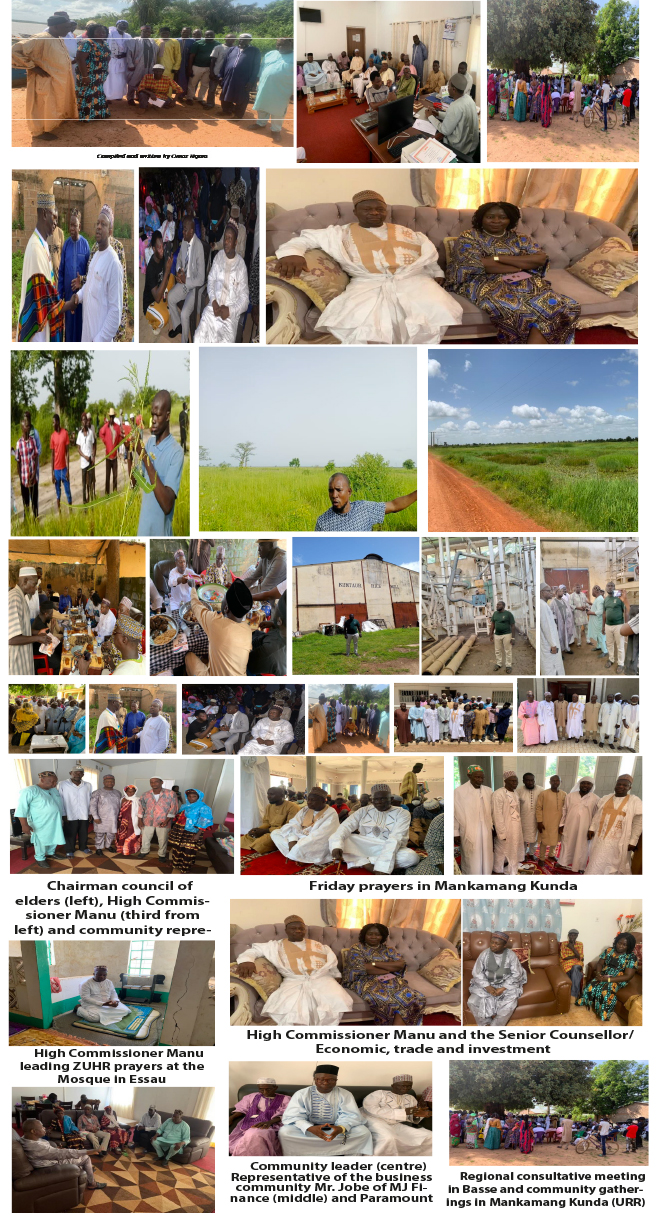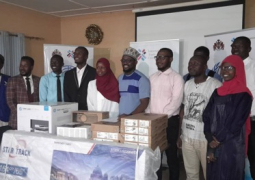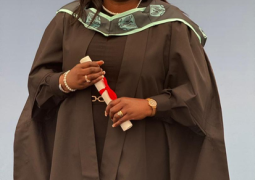
The Council Elders was led by the Chairman Mr. Falai Baldeh, who was accompanied by the Paramount Chief, the Director of Raid Gambia, The Chief Executive Officer (CEO) of MJ Finance (representing the business community), media personnel, and other members. On the other hand, the Nigerian delegation was led by the High Commissioner Mr. Muhammad Manu, and other staff members (See annex for the full list of names). HE the President of the Republic provided support to the Gambian team in the form of fuel and vehicles. In each of the regions, the visiting delegation was received by the governors, district chiefs, community/women and youth leaders, key stakeholder institutions who are also members of the regional technical advisory committees, and large crowds of enthusiastic community members.
1.Goal and Objectives
2.1. Goal
The overall objective of this exercise is to familiarise the Nigerian High Commissioner and his team with the agricultural and other development potentials of the Gambia with a view to attracting Nigerian investors as a model for economic cooperation and integration in West Africa.
2.2. Specific Objectives
The specific objectives of the exercise are summarised as follows;
Courtesy calls on regional authorities (Governors, Area council, and key regional stakeholders)
Consultations with district authorities (chiefs) and local community leaders (Alkalolu, women, and youth leaders)
Site visits to potential rice production areas in different regions.
Site visits to the rice mill and cotton ginnery (processing facilities) in Kuntaur and Basse respectively.
1.Methodology
The methodology for the consultative process was mainly participatory with open meetings and community gatherings in different places that were visited. These meetings were moderated by different personalities, welcoming and introductory statements, and keynote remarks by the Nigerian High commissioner.
The engagements in the different regions and communities visited are presented below.
- North Bank Region (NBR)
1.1. Courtesy call on the regional Governor
1.2. Courtesy calls on the District chiefs of Lower Niumi, Upper Niumi, Central Badibou and Upper Badibou
1.3. Community gatherings/consultative meetings in Essau, Jurunku, Gunjur, Njabakunda, Kerewan and Farafenni
1.4. Visit to rice fields in Jurunku
- Central River Region (CRR/North)
2.1. Site seeing of the rice mill in Kuntaur
2.2. Visit Barajally rice fields and river side
- Upper River Region (URR)
3.1. Courtesy calls on the Regional Governor and Chief of Jimara District
3.2. Meeting with Governor, local leaders and members of the Technical Advisory Committee (TAC)
3.3. Visit the cotton ginnery in Basse
3.4. Visit the rice fields in Kosemar
3.5. Community gathering in Mankamang Kunda
Curtsey call on the Chiefs of lower, upper Niumi districts and Governor NBR
1.Summary and analysis of proceedings
4.1. Summary of remarks by regional/district authorities, community and TAC members and members of the Gambian delegation
During the various community gatherings, the different speakers in all the areas visited expressed delight in receiving the delegation. The people particularly commended the High Commissioner for the bold initiative which is coming at the right time. Reference was also made to the long-standing friendly relationship between the Gambia and Nigeria (since independence), pointing at a lot of similarities in the cultures/tradition and religions of the two people. Similarly, in almost all the meetings, speaker after speaker indicated that this was the first time for such a diplomatic delegation to visit their regions, districts, and communities. One of the district chiefs described it as a ‘wonderful history’ for a High Commissioner to tour the country to explore avenues for partnership and development. In essence, therefore, the move is visionary and a step in the right direction. In their opinion, investing in agriculture and addressing the food security concerns of the country is a national priority.
Farming, including livestock rearing, was described as the main source of livelihood for the people in all the rural regions of the Gambia. However, they lamented the decline in agricultural production, with low crop yields and household incomes, thus undermining food security and worsening the poverty situation of many farmers and households. This they said is due to a combination of factors such as lack of machinery, high cost of fertilizers and other inputs, marketing constraints, lack of storage facilities, and impacts of climate change and environmental degradation (flooding, wind storms, damage to infrastructure (roads, bridges, and homes), erosion and loss of soil fertility). In one instance, it was noted that up to 90% of farmers could not afford fertilizers this year. In a similar vein, they did not lose sight of the need to improve the quality of basic social amenities such as schools, healthcare, domestic water supply, and road networks, especially in the main rice-producing areas.
For example, the community of Jurunku has initiated the construction of health facility for which support is needed. Similarly the need for linking the school in Banni with a sister school in Nigeria and establishment of a technical skills centre were expressed.
Irrespective of that, it was observed that there are vast agricultural lands with huge potentials for rice production (and all other agricultural purposes) in the different regions which are either underutilized or not exploited at all. These include Jurunku, Gunjur, Banni, and Balingho in the North Bank Region/NBR; Kuntaur, Barajally, Janjanburay, Jahally Pacharr, and others in the Central River Region (CRR); Kosemar, Bajakunda, Julangel, Banni Tenda and others in the Upper River Region (URR). URR alone is reported to have close to 10,000 hectares of irrigable land suitable for rice cultivation.
In our efforts to increase rice production, there were also calls for possible interventions in boosting the production of other cereals such as millet and maize as well as groundnuts, fruits, and vegetables. In order to reduce the amount of food imported into the country, there is great potential for fish farming and livestock production (including poultry). As such, the local authorities expressed support and willingness to make this initiative a dream come true if it is backed by a high sense of commitment and dedication at all levels. If successful, this initiative could serve as a model for regional integration. On that note, the
Regional and community consultative meetings in URR
Governor of URR pointed out the need to create linkages with their counterparts (State Governors) in Nigeria to further advance and strengthen the cooperation. It was intimated that the strive for food sufficiency is a huge challenge not only for the Gambia but the whole of Africa. Hence there is an urgent need, especially for us in West Africa to utilize our abundant natural resources to address the food security challenge. For one of the local community leaders, Nigeria alone can feed the West African sub-region.
4.2. Summary of remarks by the Nigerian High Commissioner and his team
High Nigerian High Commissioner thanked all those involved for the warm reception throughout the visit, describing it as a demonstration of love and cordial brotherly ties between the two countries. This was further exemplified when he met a Nigerian lady of the same native language in one of the villages visited. Also, the fact that his daughter is married to a Gambian makes him feel really at home. Although the countries are far apart, we are the same people and hence there is an urgent need to close the existing gaps by strengthening ties in all sectors. Following contacts with the national council of elders some months ago, he pointed out there is a cordial political relationship and that this initiative is in line with the broader philosophy of finding ways to link the economies of the two countries to benefit the two people.
He noted that the first step in fostering this philosophy was to invite the Emir of Kanu (the second richest state in Nigeria) who came to the Gambia with a group of investors. The Emir and his delegation were in the country for one week, during which they met with Gambian investors and visited agricultural lands and other sectors of the economy. The current. agricultural tour is a follow-up to that visit
The High Commissioner and Senior Counsellor/Economic, trade and investment
In pursuit of the above-stated aim, the High Commissioner announced the organization of a joint trade fair between Gambian and Nigerian businesses to be held in the Gambia next week. This he said, will go a long way in promoting made-in-Gambia and made-in-Nigeria products and will help in building rapport, familiarity, and possible exchanges between investors and business enterprises of the two countries.
He informed the regional and district authorities and local community leaders that Nigeria has achieved a lot in the area of food production, considering that, under the present government the country no longer imports rice. The realization of this goal he said is complemented with the establishment of industrial processing plants/facilities which has, in turn, created employment opportunities for many people. It is along those lines that the High Commission wishes to invite Nigerian investors to venture into reviving agricultural food production and processing in the Gambia, based on the Nigerian experience.
Vast underutilized and undeveloped rice fields in different regions
- Facilities visited
The team visited two agricultural processing facilities; the rice mill in Kuntaur (CRR/North) and cotton ginnery in Basse (URR). Unfortunately, both facilities were found to be in a very serious state of disrepair. According to the regional and community leaders consulted in both areas, it was indicated that these plants were booming, serving both the local and export markets. However, they were quick in pointing out that those days of glory are gone as the facilities have ceased to operate for many years now, which has rendered them defunct and dilapidated.
Since food processing is an important component of the value chain, consideration should be given to possible investment in either reactivation or establishment of completely new facilities. This will go a long way in creating employment especially for young people and contribute in curbing youth irregular migration.
Whist rice production is still continues in Kuntaur (and whole of CRR) something really needs with the out dated structure and machinery to reverse the current situation. This is important especially if investments are made in expanding production. On the other hand, in the URR, the team was informed that the facility is 40% owned by government and 60% by a private foreign company. It was also observed that at some point, the company abruptly left due mainly to management related problems; that staff salaries are still in areas and that there is need to initiate a more realistic transformation process. In addition to that, cotton production has declined significantly in the area and the market is not lucrative. The machines are old, appear to be out dated and the structures have been vandalised (as in Kuntaur). To invest in cotton processing at this time may therefore not be a viable venture. Therefore, it was generally believed that a new rice and or flour mill(s) would be a better option.
The issues around the collapse of these facilities could not be adequately elaborated on the spot. Therefore, for any meaningful headway to be made in this regard, it will be necessary to conduct studies on the circumstances under which the rice mill and cotton ginnery were established and operated. This will enhance a more realistic determination of the best way forward in terms of whether to overhaul the existing facilities
or establish new processing ones.
The defunct Rice mill in Kuntaur (CRR/North) that ceased to operate many years ago
- Conclusion and Recommendations
6.1. Conclusion
In conclusion, it can be realised from the report that the tour only covered NBR, CRR/North and URR, there is evidence, in terms availability of land, that the Gambia has the potential to produce enough rice to meet the needs of the country and even export surplus produce. However, in the absence of the volume and type of investments required, this will continue to be a farfetched dream. Hence the importance of this initiative, aimed at fostering sub regional cooperation and integration in curbing the menace of poverty and food insecurity in West Africa.
The consultative meetings in all the areas visited reveal that there are vast underutilised and undeveloped farm lands which can be transformed into highly productive fields with the use of farm machinery and introduction of improved production practices. The need for food processing facilities (rice, flour, vegetables and fruits) was also emphasised.
To further buttress the above, the Nigerian High Commissioner indicated that he is impressed with the peace and stability in the Gambia. He noted that the tour has afforded him the opportunity for a rapid assessment of the Gambia’s agricultural potentials which he said includes the River Gambia which can be used both for irrigation and fishing. He recognized that some of the crop fields may even be suitable for the cultivation of wheat to feed into local flour mills. These are valuable assets and resources that should be nurtured and developed on a sustainable basis to improve livelihoods and as such, he and his team want to leave a positive legacy behind by way of a land mark intervention in the Gambia’s food self sufficiency drive..
Investing in agricultural production and processing is, without doubt, an avenue for youth employment, which in itself will contribute to addressing other critical national development challenges such as youth irregular migration, use of illicit substances, and other related social vices.
Most of the people who spoke in the different gatherings agreed on the need for more serious investments in the agricultural value chain system for food security and poverty reduction. There is therefore a need for radical reversals in the current trajectory of the rising cost of living and global food crisis. This should be pursued within the Pan-African spirit and framework, as clearly exemplified in the objectives and utterances made throughout the mission. Increasing agricultural production and improving the value chain system for different agricultural commodities will make a huge difference in the lives of the people, especially the farming community.
Existing political relations between Nigeria and Gambia were generally described as excellent but there are challenges in bringing the two people together, especially in the area of economic integration where we are still lagging behind. It was recognized that even though the Gambia and Nigeria are close to each other, we still continue to trade with more distant countries. Therefore, inviting and encouraging Nigerian investors to the Gambia for the purpose of boosting agricultural production will be an important milestone in improving livelihoods, enhancing food security and reducing poverty.
The highlight of the visit to Mankamang Kunda (the home of Gambian President Adama Barrow) was the award of Honorary Citizenship to the High Commissioner. Again he was made to feel at home away from home.
6.2. Recommendations
Need for a more detailed study on the available agricultural lands in all regions and their suitability for agricultural purposes, specifically for rice production with recommendations for the most appropriate irrigation system (tidal, pump irrigation, or boreholes). In this process, consideration should be given to the areas suitable for the cultivation of wheat and the expansion of maize as raw materials for flour.
Instead of relying entirely on rain-fed agriculture the possibility of introducing year-round farming should be considered.
Conduct detailed technical studies on the Kuntaur rice mill and Basse cotton ginnery both of which have collapsed with recommendations for reactivation or overhaul through private sector investments.
Revitalisation of the rice mill in Kuntaur (CRR), the highest rice-producing region, should be taken on as an important challenge and a national priority for investment to regain its lost glory as the central rice processing facility in the Gambia. Hence, there is an urgent need to determine what went wrong and what needs to be done. It will also be worthwhile to attract investments in the fruit and vegetable production and processing sub sector.
There is a need to consult and work closely with the Gambian private sector actors who could cooperate with Nigerian investors in sustainable food production for the local and export market.
Considering the legal and other related issues around the defunct/dilapidated cotton ginnery in Basse (URR) and the fact that cotton production has declined significantly in the area, it is recommended that the possibility of investing in completely new rice and or flour processing plant within the same complex be considered.
Convene a national food production forum with the Gambian private sector operators (GCCI, banks, development partners, etc) with a view to creating a road map for investments in the production and processing of agricultural commodities
In the face of a global decline in the supply and high cost of food commodities, there is a need to strengthen inter-African trade (which is very low at less than 25%) and cooperation, especially in food production,
It is also recommended that the Nigerian High Commission initiates a process of forging linkages between local government authorities and schools in the two countries. As indicated in the report, Basse Area Council and the school in Banni can be used as pilot cases models for replication based on lessons learnt.
Engage the Ministry of Agriculture and the Gambia’s development partners (such as UNDP, FAO, IFAD, EU, WB and others) as important stakeholders in this process.



